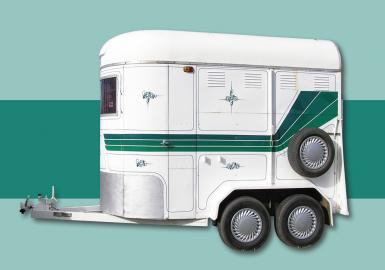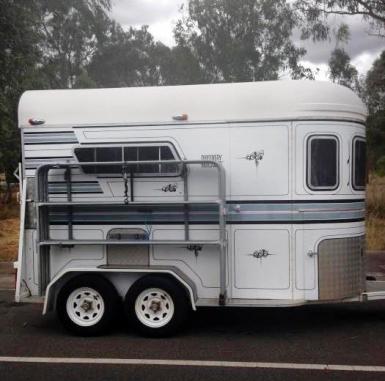Horsezone News
Reducing Stress When Transporting Horses
From the August 2014 issue of The Stable Magazine – www.thestablemagazine.com/august2014
 |
 |
|
FOR SALE: Brand new Isuzu 5 horse truck |
Travelling with your horse can be a stressful experience for both you and your horse. Be it a short trip down the road or a long haul journey, there are quite a number of factors to consider, including the safety and maintenance of both vehicles (car and float) as well as the animal welfare side of things. There is always a certain level of stress involved for your horse, even if he loads willingly onto your float, so the comfort and safety of your horse should be your top priority. So before you set out on your journey, read on for our tips and hints to ensure your trip is as safe and stress free as possible!
DIY Travel - Safety First!
It’s important to make necessary safety checks before you set out. Your car and float should both be in good working condition. Before each trip check your float for signs of wear, particularly if you do not float your horse regularly.
Risk factors while travelling include injury to horses - accidents, sudden stops, horses falling or losing their balance. Horses can also suffer extreme fatigue and exhaustion which can lead to collapse. Dehydration can also occur, particularly when away from home. Some horses get used to drinking from a particular water source, and when away from home may refuse to drink water supplied to them.
Keeping your horse well hydrated is important, not only as they can dehydrate quickly, but when exercise (sweat/fluid loss) is also coupled with travelling, as it is when you attend a lesson or a show, it can mean that the stress of travel can compound or accelerate the dehydration.
Before you leave, ensure your horse has been healthy in the lead-up to the trip, that he or she is in good health, and has been drinking normally prior to setting out. Avoid transporting horses who are ill or showing early signs of illness (elevated temperature, loss of appetite, signs of discomfort, nasal discharge, etc.), unless it is necessary for veterinary treatment.
Studies have been undertaken to determine the stress of travel, in particular the amount of fatigue suffered by horses during travel. In an article on the Kentucky Equine Researchwebsite, (www.ker.com) some interesting statistics are discussed. Long travel of over 900 kilometres can have a significant impact on the horse, with changes evident in both blood profiles (measuring levels of hormones and chemicals) and in the signs of fatigue exhibited by the horses. Trips of under 90kms should usually not lead to a loss of ability to exercise of any significant change in blood profiles in a healthy horse. Trips of over 900km usually require a rest period of a few days before the horse is given any strenuous exercise.
The KER article also refers to two studies undertaken to determine the effects of travel on the horses level of hydration. The horses in the study had been transported in small trailers for 24 hours.
“When the outside temperature averaged 27.3C horses lost more than twice as much weight from dehydration than when the outside temperature averaged 21.5C.”
“Dehydration can be moderated by offering water periodically during transport, although horses may repeatedly refuse to drink. Dehydrated horses may sometimes drink to excess, resulting in colic if they are given unlimited access to water. One study showed that giving severely dehydrated horses 12 litres if water at 30-minute intervals led to colic signs, while in another study moderately dehydrated horses drank 14 litres if water at 30-minute intervals... Dehydrated horses should be carefully observed for signs of distress while they are being rehydrated and should not immediately be given free access to water after a long period of transport.”
Read the full article at: http://www.ker.com/library/equinereview/2010/11/transporting-horses-management-to-minimize-stress.html
Respiratory problems are another risk factor when transporting horses. Ventilation in floats, coupled with lengthy travel time where the horse is not able to lower his head can lead to bacterial infections caused by a build up of mucous secretions in the airways. Horses should be given a break every three hours or so, and unloaded and allowed to graze, which in turn will allow mucus secretions to drain.
Floats with poor ventilation can also be a contributing factor to respiratory problems, as can feeding of hay in the float, where hay particles and dust can be released when the horse breaks a mouthful from his biscuit. Symptoms of respiratory disease can become evident whilst the horse is in transit, or between 24 hours to seven days following travel. Horses suffering respiratory infections will exhibit an elevated temperature, and other symptoms may include depression, loss of appetite, increased respiration rate (shorter, shallow breaths), coughing and/or nasal discharge.
If you’ve been away from home for a competition, always ensure that the horse is cooled off completely, and allow ample time for him to graze, drink some water and relax before loading him into the float for the journey home. (There’s one reason to stick around for presentations!)
The stress factor for your horse doesn’t have to be associated with just the idea of being inside the float, although certainly, the ride in a hot metal box along a bumpy road certainly can’t be pleasant!
Stress factors
The following factors have been pinpointed as stress factors for horses travelling in floats or trucks:
- The vibration and noise of the moving vehicle
- The horse having to balance himself through turns, inclines, declines, sudden stops and during acceleration & deceleration
- Lack of ventilation/poor ventilation in the vehicle
- Confinement and higher temperatures in floats and trucks
- Exhaust fumes and dust in the air from hay or bedding
- Dehydration and fatigue (particularly on long trips)
Studies in Japan involving Throughbreds who travelled for between 12 and 36 hours showed that even a 12 hour trip can affect the horse’s immune system, requiring a rest period of several days to recuperate. Of the horses who travelled for an extended period of 36 hours, more than 43% developed a fever.
Although a 36 hour trip would be unheard of for the majority of our horses, it serves to highlight the stresses that transport can place on the horse. This is why a well ventilated float and regular rest stops are so important!
Did you know?
We always load the heaviest horse on the right hand side, or, if only one horse is travelling, load him on the right hand side of the float. Why? Because our roads are slightly convex - they are slightly higher in the centre and fall away on the edges. Placing the horse (or the heaviest horse) on the right side of the floats assists in balancing the float.
Appropriate attire for your horse!
To rug or not to rug? Travel boots or none?
Basically, what your horse should wear is dependent on many factors. Your should not always rug your horse in the float. It’s important to remember that float, particularly if not open or well ventilated can be like a hot box in the warmer weather. Dress your horse appropriately for the conditions and the length of your journey. Protective boots can be an asset but only if they are well fitted. Loose boots or tired velcro can cause more problems on than off - anything that will interfere with the horse’s ability to right his balance in the float should be left off.
What to look for in a float
Many float manufacturers are now including added features for the comfort of your horse and for your peace of mind. Long gone are the days where a float as just a float. Now we have straight load, angle load, a myriad of extras or add-ons, ventilation systems, exhaust fume diverters and other clever modern inventions designed to make your journey a pleasure rather than a hassle. (Although no float manufacturer can make a float that guarantees bad loaders will willingly climb aboard, so there still may be a struggle with the loading process!)
Even the standard of hire floats seems to have improved, although all care should be taken when hiring a horse float. There are multitudes of horror stories on the topic of poorly maintained trailers owned by large trailer hire companies. Try to find a hire company that specialises in floats, and whoever you hire your float from, inspect it thoroughly before you hitch it to the car and drive away.
When looking for a float to purchase, be prepared to spend your money on a good quality float. Skimping on the purchase price or choosing an old broken down float can be more trouble than it’s worth (unless you have the skill and know-how to carry out professional repairs yourself). Newer floats tend to have improved ventilation systems, and more expensive models should feature better suspension systems than older style models, making for a more comfortable ride.
Is your float roadworthy?
As floats are often used seasonally (in warmer months when we’re all keen to get our and compete, or travel to other destinations for trail riding) there is a risk that if not housed or cared for correctly, that your float may suffer degradation during periods of little use. Placing a plastic bag securely over your coupling can assist in keeping it rust free, and parking your float on a concrete surface can help in keeping rising damp from damaging your float floor.
Before you set out check all couplings for rust, wear or damage. Check your tyres (for signs of wear, and ensure they are inflated according to the manufacturer’s instructions), the towbar on your vehicle, wheel bearings and the wiring for your lights. Always check that your float complies with all laws and regulations for your governing road transport body.
Tying horses up in floats...
Some people prefer to use breakable halters (such as leather as opposed to unbreakable, nylon halters), and horses are tied to baling twine or clever inventions such as the ‘V-Tie’ or ‘EquiTie’ - both available from Grosvenor Park Products - www.grosvenorparkproducts.com.au, or the Safe-T-Tie, available from Gone Riding - www.goneriding.com.au
In any case, while you do not want your horse loose when you’re out and about, it is generally preferable to have your horse tethered to a breakable tie, rather than a solid object. A horse who pulls back and who is tethered to a solid object (just as a fence post of chest bar in a float) can do more damage to themselves than if they are able to pull back and the tie releases.
You should always have a handler in the float to untie and hold the horse before the tailgate and ramp are unfastened. Horses who rush out backwards can be extremely dangerous, and time should be taken to attempt to better accustom the horse with the float and to re-establish ground handling methods. Putting a bit of time in on the ground to practice loading and unloading can make your actual trips a much less stressful experience!
Using a professional transport company
Using a reputable transport company to move your horse from ‘A’ to ‘B’, particularly if you don’t have your own float or towing vehicle is a wonderful idea. The best way to find someone to transport your horse is through word of mouth. You know what horse people are like - news of a job well done will travel far. News of a job poorly done? The same. Whoever you get to transport your horse should be experienced handling horses and have a purpose built vehicle - whether it is a truck or a float, it should be made for the job of moving horses, and should not be just some truck driver dude with a poorly re-purposed furniture truck. (Trust me, they are out there.)
An understanding of the care your horse requires while in transit is so important, even if your journey is only a quick trip. Certainly, long haul or interstate travel is definitely best left to the experts. Generally companies on big runs around the country will have designated rest stops, and adhere to animal welfare guidelines when transporting horses. Again, choose a company highly recommended by others.
Ensure you discuss your needs with the transport company. Not just the pick up and drop off address, but enquire as to the number of rest stops, whether overnight accommodation is provided for your horse on long trips, and ask about the transport conditions in the truck. Of course, you can’t expect a luxury stable on wheels, but you can expect safe and comfortable transport for your horse. If your horse is particularly small or particularly large, it can be a good idea to check as to whether their trucks will accommodate your horse. The last thing you want is your 17.2hh Clydesdale cross crammed into a regular sized bay, or your small Shetland wandering around under dividers!
Advantages of trucking
Trucking is often preferable to floating horses who are not wonderful loaders or good travellers. Purpose built transport trucks offer roomy quarters, where horses are able to balance themselves adequately. The suspension is likely to be much better, and the journey in the hands of an experienced truck driver should be preferable to a small and rickety float. Horses who refuse to load on to a float have been known to walk onto a truck without batting an eyelid!
Transporting your horse really comes down to common sense. Keep safety at the forefront of your mind, take all necessary precautions, ensure your vehicle and float are well maintained, take your time when out on the road, and ensure you check your horse regularly. This should allow for a safe and stress free journey!
READ THIS ARTICLE IN THE STABLE MAGAZINE FOR A LIST OF HORSE TRANSPORTING "DO'S AND DON'TS"!
Thank you to The Stable Magazine for this article, which was originally published in their August 2014 issue. Check out The Stable Magazine online now for FREE. Read this article and many more at www.thestablemagazine.com
News Search
Categories
- General
- Event Results
- Stallionzone
- Sponsored Shows
- Clubs
- Health
- Feature Horses
- Competitions
- Five Minutes With Horsezone
- Young Riders
- Reviews
- Training and Clinics
- Postcards from the saddle
- 2014 Equitana by HORSE FIRST
- 2013 Equitana
- 2012 Equitana
- 2012 London
- 2011 Equitana
- 2011 Queensland Floods
- 2010 WEG


